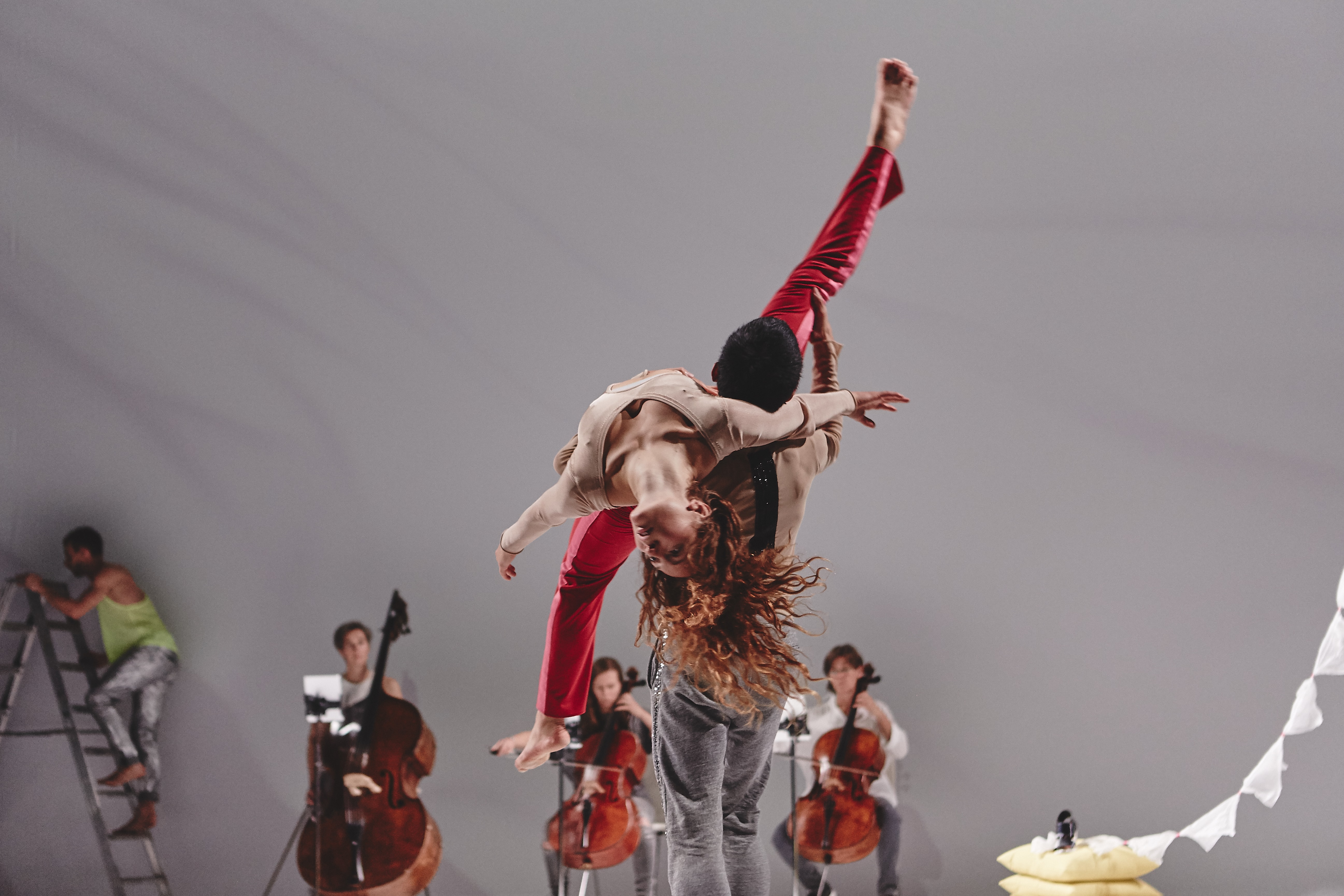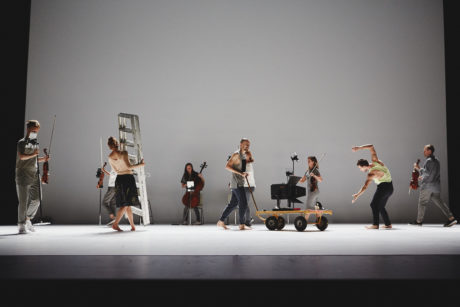Making the extraordinary ordinary appears to be a notion we can’t shake. If it isn’t dumbing down, it’s taking down, mashing up or just plain copying. Thursday, April 26 at the Kennedy Center’s Eisenhower Theater, Johann Sebastian Bach’s Goldberg Variations ceded center stage to the Swedish dance troupe Andersson Dance. The result? A takedown of high art.

Bach’s 30 variations, composed in 1741, together are at once a soaring example of compositional excellence, playing variation after variation on a theme, and a musical Mount Everest to which classical musicians aspire. Originally meant for harpsichord but now most frequently played on piano, mastery of the work is a sign of prodigious technical and artistic prowess. Scottish Ensemble, under the artistic direction of Jonathan Morton, played fearlessly and wholeheartedly using the Sitkovetsky transposition for strings as they traversed the Eisenhower stage.
Joining them, and occasionally upstaging them, the five dancers of Andersson Dance skipped and goofed, wiggled and galloped, playing with found-object props and lights, and as often as not moving against the musical themes, rather than dancing with them in expected fashion. This collaborative effort provided a meeting of high classicism and iconoclastic post-modernism. It was a clash of cultures and artistic temperaments. A meetup and a takedown.
The result? At times the meanderings and off-the-wall antics of the dancers proved funny, odd, frustrating, intriguing, boring, ridiculous and arbitrary. The music and musicians? They kept the performance on track, more than holding their own amid the tyranny of dance non-sequiturs. (Really, can anyone with consequential training and commitment ruin or put to shame the transcendent score?) The choreography? Let’s just say, it’s not a work for the ages, but seems to suit some segment of an audience that doesn’t want too much of highbrow sentiment.
During the program’s 75 minutes, one of the best things about it was the continuing evolution of music and choreography. If something displeased – like the klieg light in the, perhaps, sixth variation that shone directly in my eyes — wait two minutes, and something else would happen. Maybe a dancer will gently nudge the elbow of a violinist as he strokes a final note, or a male dancer will strip down to his tee-shirt and underpants, or another will straddle the top of a ladder and silently pontificate atop it as violins, violas, cellos and double bass continue to make beautiful and compelling music.

Orjan Andersson’s Stockholm-based pick-up company of three men and two women deconstructs the variations as they are being played with a self-conscious sense of quirky seriousness. Clad in a miscellany of streetwear on the grayscale palette, the dancers wiggle, jiggle, jostle, stretch and rebound and though they’re not dancing with the music, they are dancing to it, just as I might crank up the radio in my kitchen and let loose. While these moments might feel improvised, Andersson stated that the majority of the choreography is set and does not change. The casual, though often not technical attack, recalls the loose-limbed release technique, which had been much in vogue in some modern dance circles in recent years. However, on the Eisenhower stage, there is little intimacy. While the dancers are taking turns in singles, pairs, and trios performing Andersson’s task-like invocations of movement, the instrumental ensemble remains standing, at times walking, in mundane, person-on-the-street fashion. The violin and viola players remain standing, while the cellos and double bass mostly stay seated closer to the back of the stage.
While the choreographer has gifted viewers with some witty moments, the most compelling choreographic moments are the silences, some rather lengthy between movements. Like musical rests, they imbue additional meaning, at times even gravitas. Early on some of the variations are introduced with pity statements announced by a dancer. But soon the variations are played straight through. Especially telling is that they often come in the first half when the initial variations are introduced with a short announcement and explanation. Here and there a smattering of chuckles indicated that some in the audience grasped the self-consciously post-modernist regard Andersson has usurped. Others might just be left scratching their heads. Sometimes the dance action on stage looks like a handful of unruly toddlers got loose and there’s no one to pick up their toys.
Most interesting were moments when Andersson used both ensembles, mapping out paths for the musicians to navigate en masse with everyday pedestrian walks. Later, two instrumentalists put down their instruments to move. They use their bodies to make sounds – play music – by clapping, rubbing their palms together, snapping their fingers, even taking heavy breaths. The sounds aren’t symphonic, but the performers, both women, are committed to exploring this extracurricular aspect of classical music.
Andersson’s interpretation of Goldberg Variations self-consciously takes down high art. The final sections feature a stage that has filled up with flotsam and jetsam – objects “borrowed” from their Stockholm theater – a quartet of sofa pillows, a clothing rack with sundry dresses and tops, a pair of bowls, a single wedge shoe. The performers – musicians and dancers – are assigned to gather and make “one-minute sculptures” – assemblages of found objects. In that Andersson acknowledges his debt to Dadaism and Dada’s philosophical and artistic hero Marcel Duchamp – he of the pissoir, his 1914 museum exhibition piece “Fountain.”

This oddball confluence of classicism and post-modernism features a group of lovely dancers. Andersson, a one-time soccer player who came to dance late, lucked out with Jozsef Forro, Eve Ganneau, Paul Pui Wo Lee, Javier Perez Perez and Stacey Aung. They can appear serene or goofy as they soar and squat, stretch and melt with equal aplomb. They’re dexterous, eager and fluid even in the quirky touches Andersson uses to punctuate his notions of the flexibility of Bach’s score.
Goldberg Variations is a touchstone work. This version – subtitled “ternary patterns for insomnia” – makes a play on the composition’s origin story (perhaps apocryphal): the work was commissioned to help assuage Count Kaiserling’s sleepless nights, when he would call for his harpsichordist, named Goldberg, to play him to sleep. For those non-math folks, ternary refers to groupings of three (I had to look it up). While trios and other evolving groupings occur, the reference is a mathematical and musical conundrum.
It’s hard to tell if Andersson is paying homage to the Judson Church movement’s avant-garde dismantling of virtuosity and technique, or if he’s just playing using these borrowed principles for his own pleasure – and notoriety. Either way, there are clear connections — even an additive solo of repeated uninflected gestures that feels a little too much like Trisha Brown’s historic work “Accumulation.” In 1965, another dance post-modernist, Yvonne Rainer, penned her now-famous “No Manifesto,” which proclaimed: “No to spectacle. No to virtuosity. No to transformations and magic and make-believe.” It was a fervent statement of its time. A way to break away from and break down the status quo. Andersson has perhaps found new relevance in snubbing virtuosity for the pedestrian as a reaction to a new 21st-century normal. He’s thumbing his nose at the highbrow and bringing Bach down a notch. Guess what? Bach can take it. His compositions have been hanging around for a couple of centuries and aren’t going anywhere. Andersson gave it a valiant effort, but Bach still wins.
Running Time: 75 minutes, with no intermission.
Goldberg Variations – ternary patterns for insomnia with Andersson Dance and Scottish Ensemble, plays through Saturday, April 28, 2018, at the Kennedy Center – 2700 F Street, NW, in Washington, DC. For tickets, call (202) 467-4600, or purchase them online.




